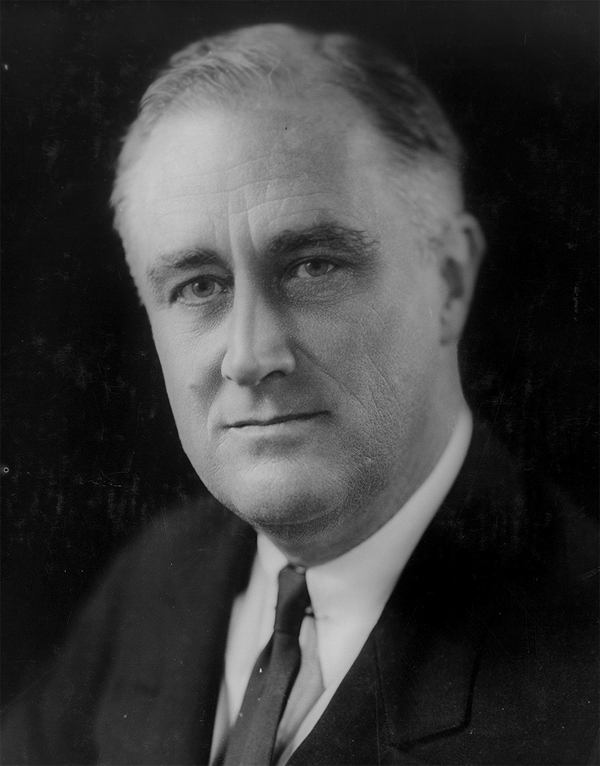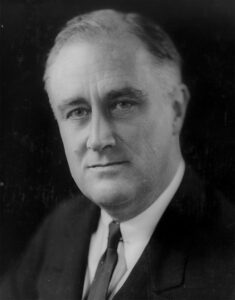New Deal in Louisiana
Franklin Delano Roosevelt’s New Deal brought jobs and resources to Louisiana during the Great Depression.

Courtesy of Library of Congress Prints and Photographs Division
Franklin Delano Roosevelt.
T he New Deal arrived in Louisiana in the spring of 1933 on the heels of President Franklin D. Roosevelt’s (FDR) electoral victory over Herbert Hoover the previous fall. After a four-month interim between his election and inauguration, FDR and his “brain trust” of economists, social scientists, and progressive reformers unleashed a wide array of programs aimed at relieving the deep structural problems plaguing America in the midst of the Great Depression. These “New Dealers” achieved an impressive, if uneven, legacy. Although often viewed in populist terms, the early New Deal in fact tended to benefit corporate America more than those on the margins of society. It was this failure to solve the problems of the so-called “forgotten man” that gave rise to controversial figures on the left like Huey P. Long and Father Charles Coughlin, who clamored for even more radical action. Responding to their criticism, FDR focused his efforts more sharply on relief during the period of the “second New Deal” in 1935–36. Still, FDR and his advisors always saw these as emergency measures, not permanent fixtures in a larger political program. Even with such flaws and inconsistencies, the New Deal represented to many Louisianans at the time, and certainly in retrospect, an intense commitment on the part of the federal government to help a struggling people.
Relief for the Unemployed
Nowhere was this commitment more apparent than in the administration of relief. With perhaps a quarter of the American workforce unemployed in the winter of 1932–33, immediate financial assistance and public works programs were of the highest priority. Building upon Hoover’s limited relief apparatus, FDR added a bevy of new federal bureaucracies to bring aid to the nation’s impoverished masses. The primary vehicle for relief distribution was the Federal Emergency Relief Administration (FERA), which worked through state-level offices to dole out clothing, food, medicine, and cash to eligible families. Other agencies, most notably the Civil Works Administration (CWA), Public Works Administration (PWA), and Civilian Conservation Corps (CCC), enrolled unemployed workers—from architects and engineers to mechanics and day laborers—to work on thousands of federally funded construction projects across the country.
In Louisiana as elsewhere, these relief efforts had an immediate impact. By January 1934, FERA was providing aid to some 400,000 Louisianans (almost 20 percent of the state’s population) and, by March of that year, had expended almost $32 million on its in-state operations. The CWA, a temporary sub-agency of FERA, paid out close to $15 million for wages and materials. In addition, the CCC developed reforestation, erosion, park-building, and road construction projects in the state and eventually employed more than 42,000 young men, including more than 8,000 African Americans. Kisatchie National Forest and the early State Parks system, for example, were almost entirely CCC creations.
Huey Long and the New Deal
Ultimately, though, a conflict brewing on the national stage between FDR and Louisiana’s strongman, US Senator Huey P. Long, undercut the effectiveness of relief in the state. Anxious to prevent the federal government from interfering in Louisiana politics, Long worked to limit the New Deal’s influence. His efforts increased as FDR funneled more and more funds and patronage through the political opposition, the “anti-Longs.” While other states experienced a major influx of federal money during the mid-1930s, leading to a surge in public employment and building, Louisiana actually endured a period of self-imposed denial. It was not until FERA temporarily pulled the plug on relief assistance in August 1934, threatening his popularity with the masses, that Long complied with a mandate to establish a public welfare department in the state. Further, through the drawn-out process of bureaucratic review, Long effectively held up numerous PWA projects; in fact, fewer than three dozen were fully authorized before his death in September 1935.
As beloved as Long was by the state’s working classes, his demise brought them, and Louisiana, a greater share of the New Deal’s spoils. Realizing their political vulnerability, Long’s successors—Governor Richard Leche and New Orleans Mayor Bob Maestri, among others—offered to drop their deceased leader’s controversial Share Our Wealth program and fully support FDR and the New Deal. In return, FDR promised federal dollars for public works in Louisiana, a deal cynically referred to by many as the second Louisiana Purchase. Thus, Louisiana experienced the most tangible benefits of the New Deal in the years between 1937 and 1940 rather than earlier in the decade, as was the case elsewhere.
Public Works Projects
Among the most active agencies at work during this era in Louisiana history was the PWA, which by mid-1939 had spent more than $79 million on various projects, including the expansion of the Barksdale military base outside Shreveport; the building of Charity Hospital and the Huey P. Long Bridge in New Orleans; and the construction of classrooms, offices, shops, and other facilities at Louisiana’s major colleges and universities. The PWA built more than four hundred structures in the state and renovated many more, including civic buildings, community centers, courthouses, and airports.
The Works Progress Administration (WPA), established during the second New Deal of 1935, also proved productive, expending upwards of $80 million on roads, bridges, water and sewerage systems, parks, playgrounds, public housing, and other projects in Louisiana. Further, the WPA oversaw a variety of relief and work activities, including hot lunch, library, and bookmobile programs; educational and vocational classes; and literacy drives. It is perhaps best remembered, however, for the Federal One program, which included the establishment of the Louisiana Writers Project, the Louisiana branch of the Federal Art Project, and similar programs in music and theatre. These agencies, some of the most creative as well as politically left-leaning of the New Deal, employed writers, historians, musicians, artists, and actors in a wide assortment of public efforts aimed at increasing the appreciation of American regional cultures in the transitional decade of the 1930s.
Agricultural Reform
Although these highly visible PWA and WPA projects resonate as the “face” of the New Deal today, larger structural reforms, especially in agriculture, had a much more substantial impact on Louisiana both at the time and later on. The Agricultural Adjustment Administration (AAA) fundamentally altered rural life by instituting a system that favored large-scale, commercial operations over the traditional small farm. Louisiana’s rice and sugar industries already enjoyed a high level of capitalization, and in these cases the AAA program simply reinforced prevailing tendencies toward “bigness” by providing government support and market stability.
In cotton, however, the AAA helped to completely overthrow the old order that had prevailed since the end of the Civil War. Under the AAA plan, cotton farmers were incentivized to reduce production by limiting their total acreage. The subsequent reduction in overall crop size created an artificial shortage that then led to higher market prices, from under five cents a pound in 1931–32 to thirteen cents in 1934. In addition, the federal government allocated annual rent payments for the farmers’ now unused land. By the end of May 1936, cotton growers in Louisiana had received more than $30 million in such payments. Further, they often planted the idle acreage in forage and feed crops or turned it into pasturage, adding another benefit to the AAA package. Throughout the 1930s, as large planters and farmers diversified their crops, mechanized their operations, and reduced their dependence on hand labor, agricultural income in the state, which had sunk from $170 million in 1929 to $59 million in 1932, steadily rose toward $130 million by 1937. The course of our modern system of farm support was now set.
Unfortunately for many of Louisiana’s sharecroppers and farm laborers, the AAA program proved to be incredibly disruptive to their day-to-day lives. Nominally, landowners receiving federal rent payments were required to divide them with their tenants based on an individual’s contract status; a half-share tenant would be given half the check amount, and so on. The nature of the plantation system, already rife with exploitation, conspired against such a split, with most landowners keeping the entire check. More simply, many tenants either were moved off the land entirely or reduced in status to day labor.
Eventually, the New Dealers would attempt to remedy the government-induced plight of these poor farmers through the programs of the Resettlement Administration (RA) and its successor, the Farm Security Administration (FSA). The FSA made low-interest loans for land, equipment, and stock purchases to eligible small farmers and also set up several community farm projects, including Crew Lake, Transylvania, and Mound, all in northeastern Louisiana, and Terrebonne in the southern part of the state. In general, however, these efforts proved too limited to effect more dramatic change in the lives of most rural folks in Louisiana. As was the case with many of the New Deal’s other programs, where there were tremendous successes, there were also abundant failures and unintended outcomes.
In the wider view of history, the New Deal stabilized an economy on the precipice of total collapse and instilled a sense of purpose among a people traumatized by the fear and anxiety of the Great Depression. These are its greatest achievements. In other undertakings, success was mixed at best. Most important, FDR did create the framework for a powerful regulatory state, one that would expand its size and scope during the coming world war and in the decades after. But, limited by the bounds of American democracy and his own political miscues, FDR lacked the force of will to solve many of the deep inequities found in 1930s American society. Those problems would be left for later generations to solve.
